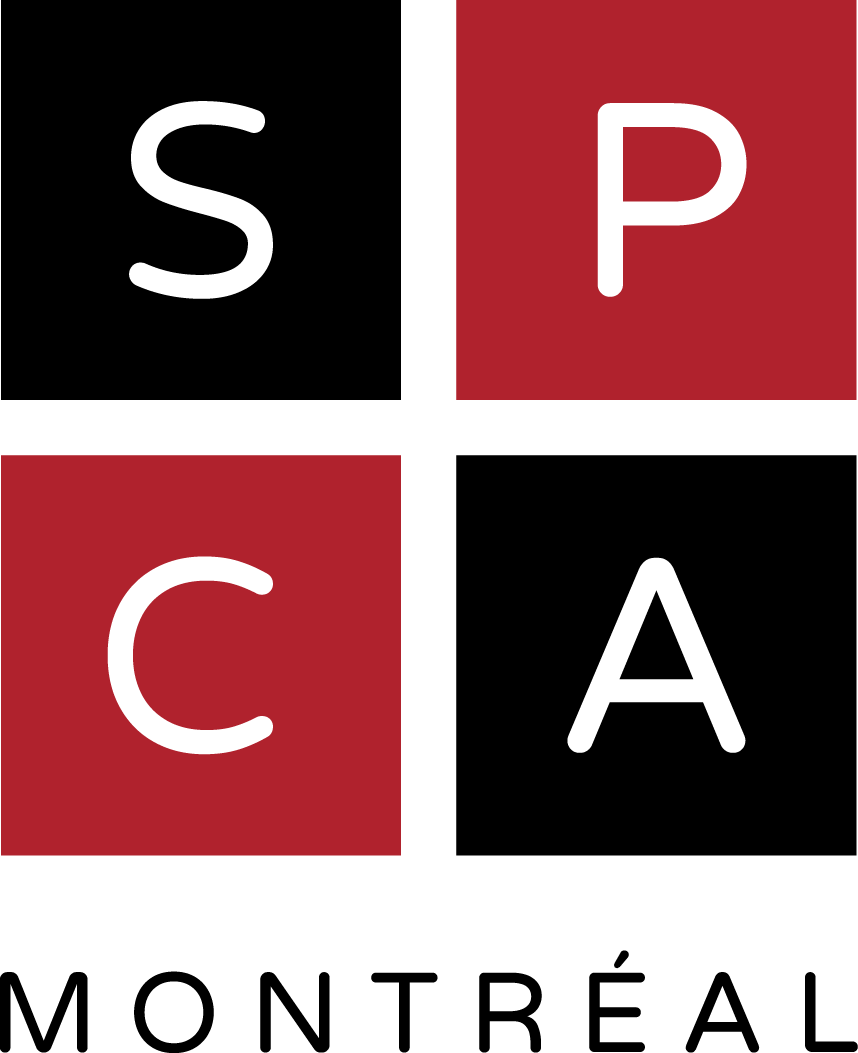Together, let’s demand a better life for sled dogs!
Dog sledding is a popular winter activity in Quebec, especially among tourists. There are over 130 sled dog facilities throughout the province, in which at least 5,000 dogs are put to work.
But behind the picture-perfect postcard images of dogs running happily through the sparkling snow lies a sad reality. Most sled dogs in Quebec are kept in conditions that do not ensure their welfare.
Like the dogs who share our lives, sled dogs deserve to be able to exercise regularly (even in summer!), move about freely during the day and play with other dogs.
They should receive individual attention on a daily basis, as well as regular veterinary care. Finally, these dogs should be able to end their days in a loving home when they become too old or unable to work.
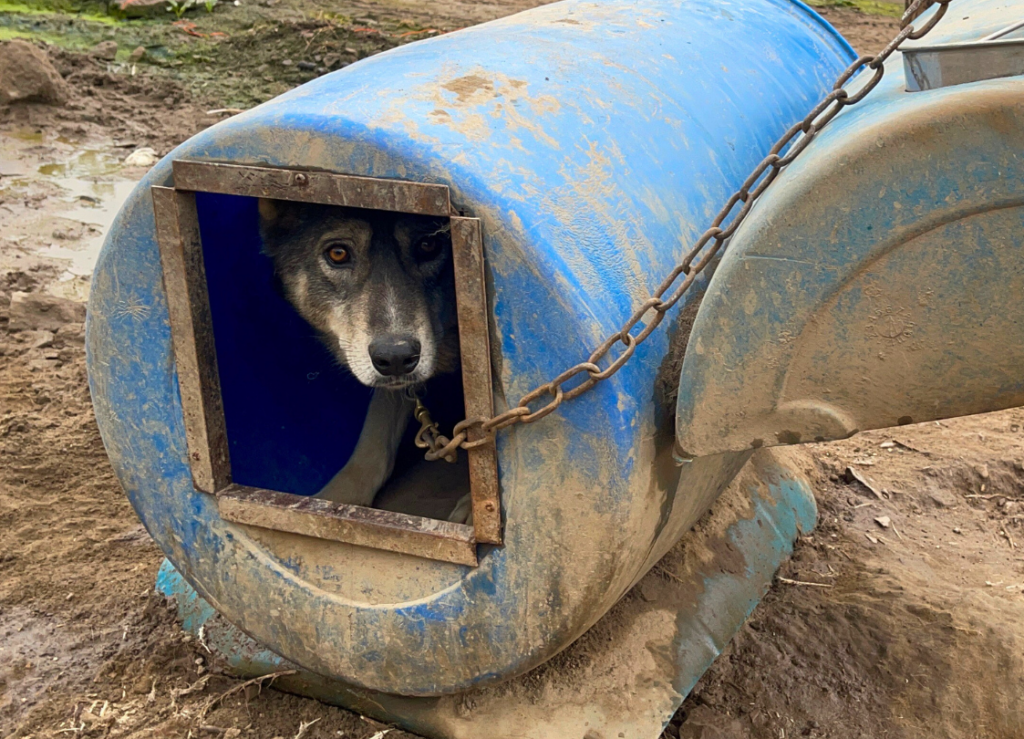
All photos on this page were taken in Quebec in 2022 by © Shay Lee, unless otherwise indicated.
Sign the petition to ask the Quebec government to provide stricter oversight of the sled dog industry.
Calling for improved protection for sled dogs
Several cruelty cases in the news
Several high-profile cases in recent years have exposed the serious animal welfare problems that are pervasive in Quebec’s sled dog industry, such as the case of Expédition Mi-Loup, whose owner was recently convicted of animal cruelty.
Let’s make sure that no more such cases occur in Quebec!
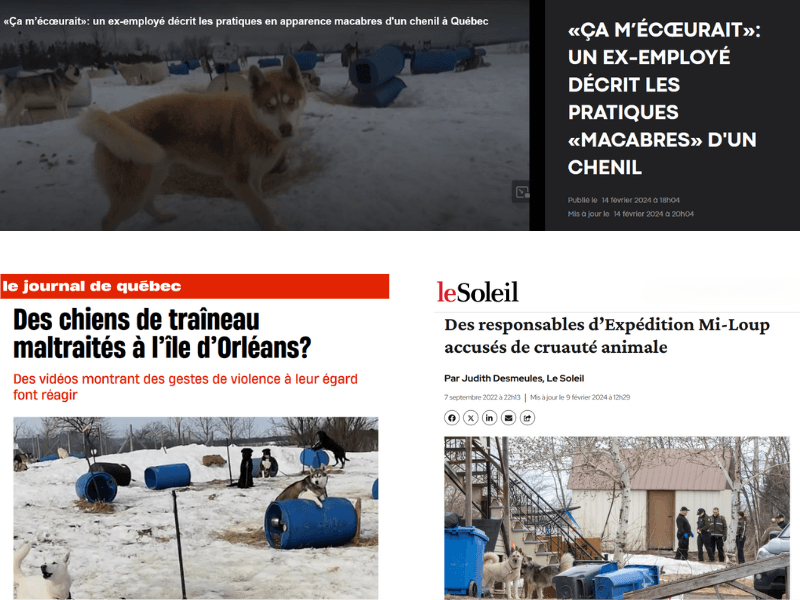
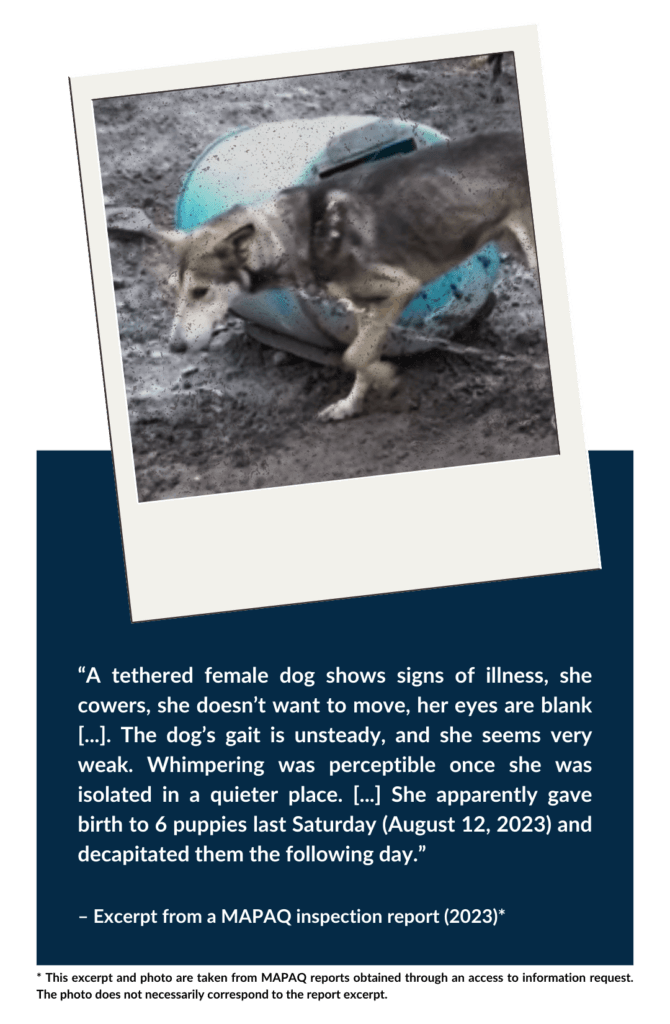

Dogs chained for most of their lives
In the sled dog industry, most dogs spend almost their entire lives tied to the end of a chain, unable to move freely.
“Dogs are social animals whose welfare depends on being able to have normal contact with other members of their species. By preventing dogs from engaging in behaviours that are critical to their mental well-being, tethering can lead to the development of stereotypical behaviours or compulsive disorders – both of which are signs of psychological distress. This is also the case for dogs who are tethered in groups, such as sled dogs, since healthy socialization requires unrestrained physical contact and play, which is impossible when they are tethered.”
– Dr. Enid Stiles, veterinary behaviourist, chair of the Animal Welfare Working Group, World Veterinary Association, and past president of the Canadian Veterinary Medical Association
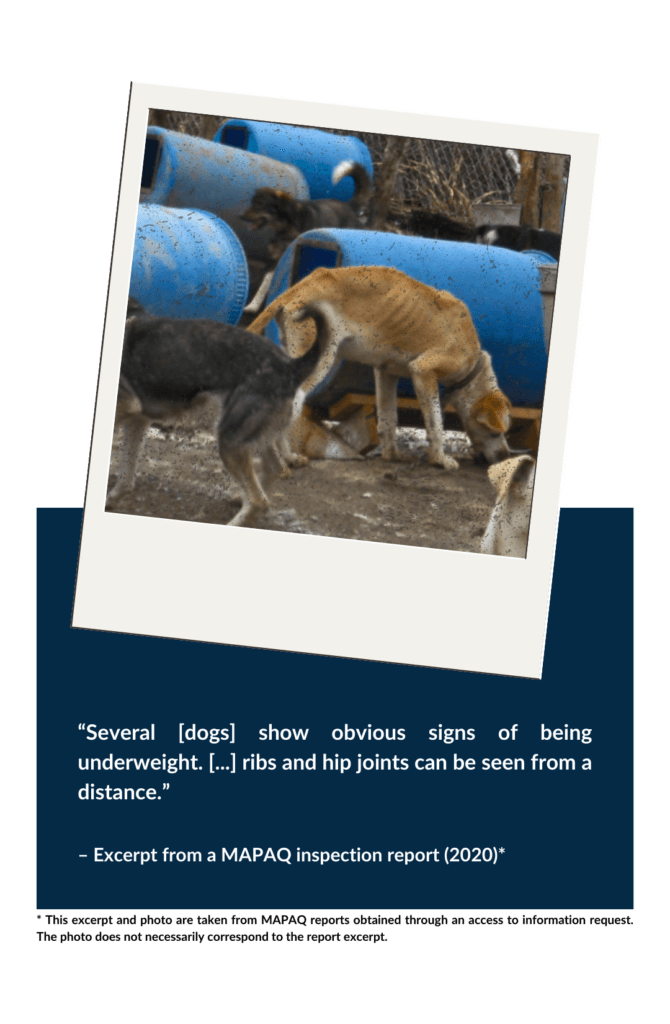
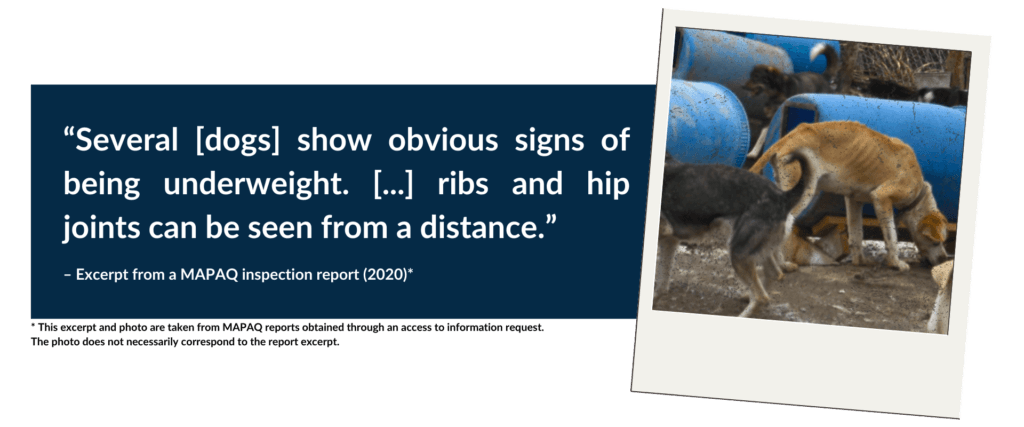
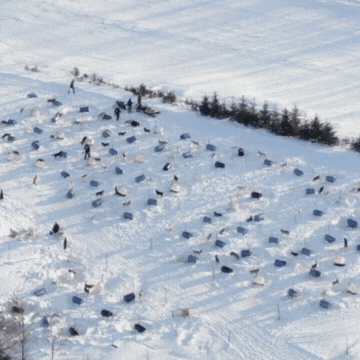
Overcrowded kennels
Few dogs working in this industry are spayed or neutered, and males and females are not always diligently separated, which results in unwanted litters and can lead to the killing of puppies.
Nearly 30 sled dog facilities in Quebec have more than 50 dogs each, and some have as many as 200. Such overcrowding makes it impossible to provide each animal with the care and attention they require, thus increasing the likelihood of neglect.
Dogs deprived of a proper retirement
After years of service, sled dogs deserve to spend the last years of their lives in loving homes. Yet true retirement programs are rare in this industry. Older animals, or those unfit to pull a sled for some other reason, are usually killed or die of old age at the end of their chain.
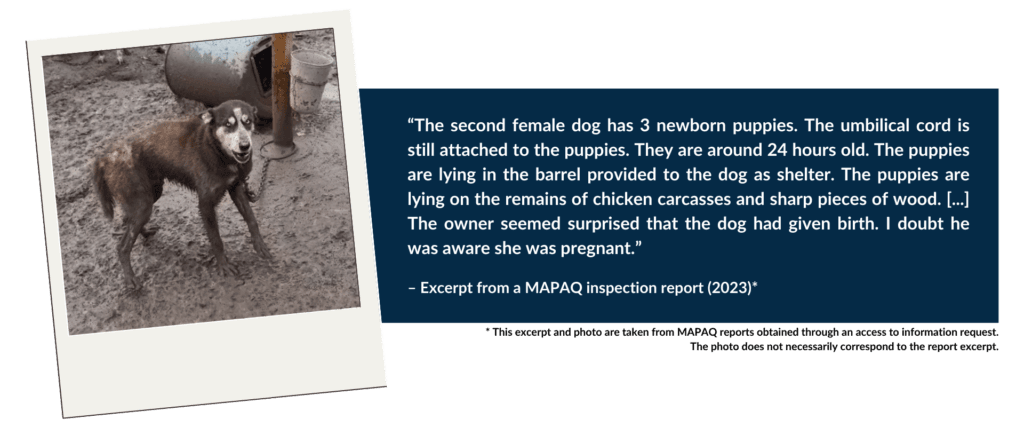
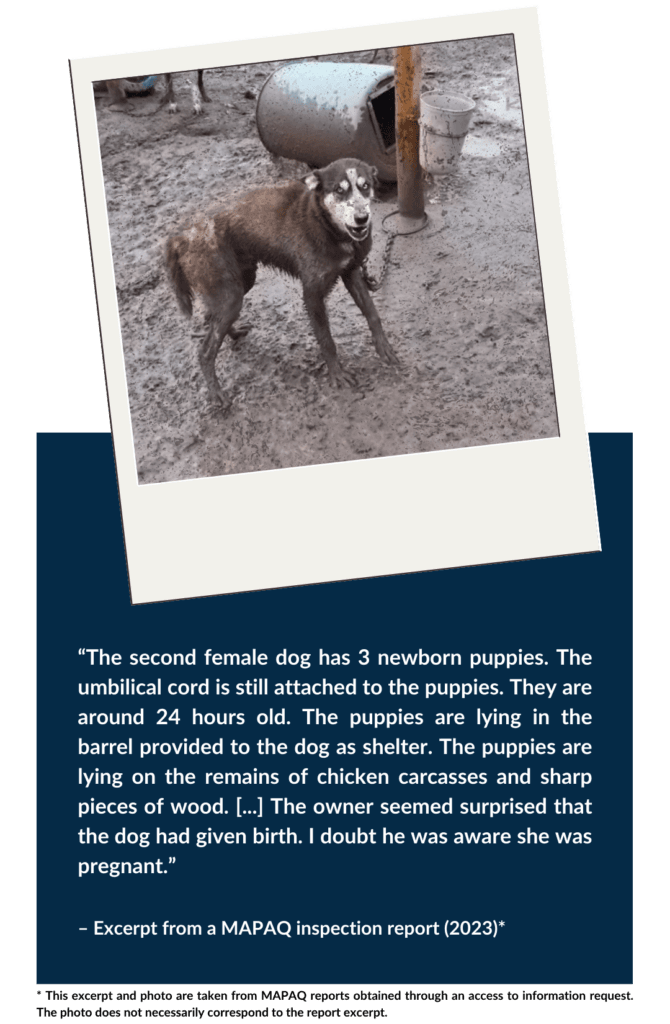
An industry that is not specifically regulated
No specific regulations exist for the 130 or so sled dog facilities in Quebec, as is the case in British Columbia, for example. It’s time for a change!
Ask the provincial government to put in place a regulatory framework specific to this industry, including mandatory standards and strict enforcement of these standards by the ministère de l’Agriculture, des Pêcheries et de l’Alimentation du Québec (MAPAQ).
To read a full list of our recommendations, click here.
In Quebec alone, over 5,000 dogs are currently at risk. These thousands of dogs are counting on you!
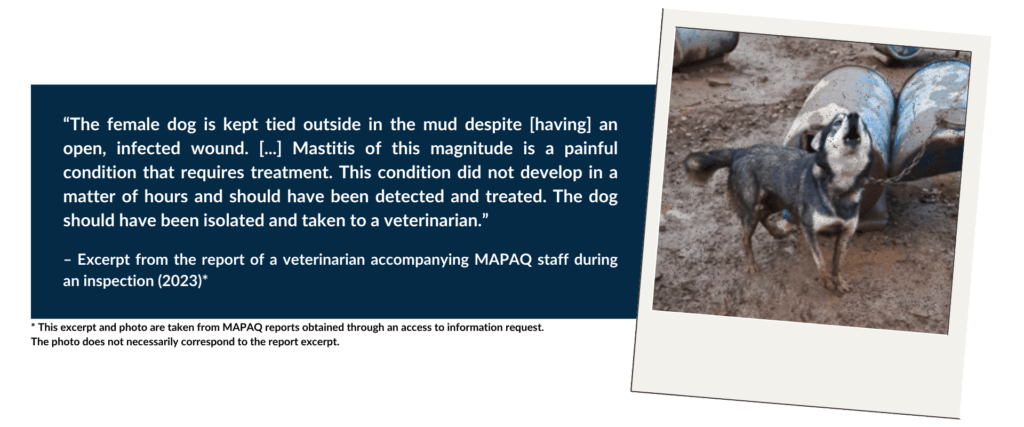
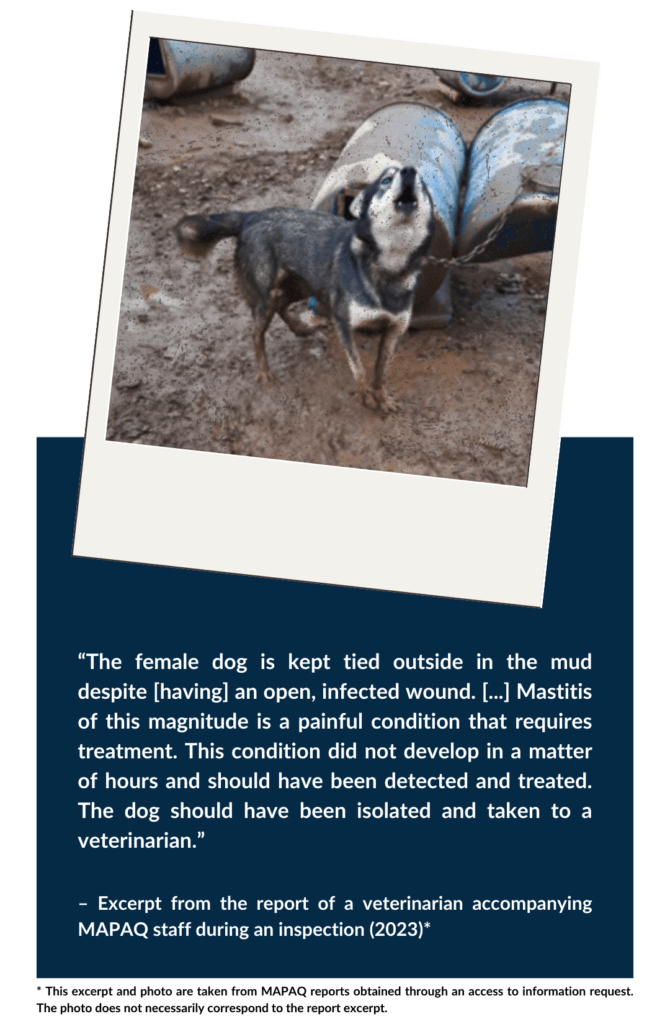
FAQ
How big is the sled dog industry in Quebec?
It is a major industry in Quebec. According to data obtained from the ministère de l’Agriculture, des Pêcheries et de l’Alimentation du Québec (MAPAQ), as of July 16, 2024, there were 134 active sled dog facilities in the province, with a total of 5,078 dogs. In terms of geographical distribution, the administrative regions with the most facilities of this type are, in descending order, Saguenay-Lac-Saint-Jean, Lanaudière, Capitale-Nationale, Mauricie and Laurentides.
What cases have made the headlines? Are they isolated instances?
A number of recent high-profile cases have highlighted serious animal welfare issues within Quebec’s sled dog industry. On June 7, 2024, the owner and an employee of Île-d’Orléans-based Expédition Mi-Loup were convicted of animal cruelty. More specifically, the owner was found guilty on three counts of willfully killing, maiming, wounding, poisoning or injuring dogs, causing unnecessary suffering to animals, and neglecting to properly feed and care for the dogs under his care. In 2022, social media posts alleged that Chenil La Poursuite in Lévis was mistreating its dogs which eventually led the MAPAQ to seize 19 dog from the facility.
Beyond such incidents of animal cruelty and offences under the law, the sled dog industry’s standard practices are problematic. Thousands of pages of documents obtained through access to information requests and reviewed by the Montreal SPCA illustrate the inadequate – yet legal – living conditions of sled dogs in Quebec. That is why a stricter regulatory framework for this industry is urgently needed.
What animal welfare issues exist within this industry?
Most sled dogs in Quebec are worked and kept in conditions that do not ensure their welfare.
- Tethering: Most dogs spend the vast majority of their lives tethered to the end of a chain, which can cause severe frustration and even psychological suffering, eventually leading to distress and the development of stereotypical or compulsive behaviours.
- Lack or failure of measures to control breeding: Few dogs are sterilized, and males and females are not always diligently separated, leading to excess births and issues related to the management of unwanted litters, sometimes resulting in the killing of puppies.
- Overcrowded kennels and lack of veterinary care: Nearly 30 Quebec sled dog facilities have more than 50 dogs each. Some have as many as 200! Such overcrowding makes it impossible to give each dog the care and attention they require. Despite the legal obligation to provide health care for sick or injured animals, sled dogs are often deprived of adequate veterinary care.
- Lack of retirement programs and life-cycle plans: After years of service, sled dogs deserve to spend the last years of their lives in loving homes. Yet true retirement programs are rare in the industry. Older animals, or those unfit to pull a sled for some other reason, are usually killed or die of old age at the end of their chain.
Why is tethering a problem?
Dogs are social animals whose welfare depends on being able to have normal physical contact and play with other dogs, which is impossible when they are tethered. Deprived of this possibility, they can develop severe frustration and even psychological suffering, eventually leading to distress and the onset of stereotypical behaviours or compulsive disorders.
Tethering also limits the possibility of adopting normal body postures, which can lead to further frustration and conflict within social groups.
Due to its detrimental impact on canine welfare, tethering is prohibited as a primary means of confinement in the Code of Practice for Canadian Kennel Operations published by the Canadian Veterinary Medical Association (CVMA).
What are the welfare issues related to uncontrolled breeding?
Unplanned breeding can be a major welfare issue, as the resulting litters of puppies are often unwanted and may be inadequately cared for or even put to death. In the case of Expédition Mi-Loup, for example, several hundred unwanted puppies a year were killed, including by being placed alive into a freezer.
Beyond the problems associated with the killing of unwanted animals, there is a negative correlation between the number of animals per facility and the quality of their care. The risk of neglect increases significantly in overcrowded kennels. In fact, it becomes very difficult to provide an acceptable level of care when too many dogs are kept in a single facility.
In Quebec, there are almost 30 sled dog facilities with more than 50 dogs each, and some have as many as 200! Such overcrowding makes it impossible to provide each animal with the care and attention they need, due to the time and resources required. In fact, despite the requirement under the Animal Welfare and Safety Act to provide health care to sick or injured animals, sled dogs are often denied adequate veterinary care.
The most effective method of preventing dogs from reproducing uncontrollably is to sterilize all individuals not intended for breeding. Contrary to popular belief, sterilization does not reduce a dog’s athletic ability. It also has a number of benefits, including making it easier for males and females to live together and reducing fighting as well as health problems.
How important is a retirement program for sled dogs?
Regardless of the role they play, all dogs deserve to be treated with dignity and respect throughout their lives. As long as they are healthy and well socialized, there is no acceptable reason to end their lives. Sled dogs are no exception. When they become too old to work, or unfit for any other reason, they should be allowed to end their days in a loving home. It’s the least they deserve after many years of service.
Stricter oversight of the sled dog industry is necessary to ensure that robust retirement programs provide a happy ending for the dogs it uses. In this respect, Quebec should follow the example of British Columbia, whose sled dog regulations require that a life-cycle plan be drawn up for each dog. This must include a socialization plan to ensure that the dog can be placed in a home when they retire, as well as a retirement plan that aims to secure an adoptive home.
What are Quebec’s current regulations?
In Quebec, the sled dog industry is not subject to any specific regulations, unlike in British Columbia. Sled dog facilities therefore fall under the general regime of the Animal Welfare and Safety Act and the Regulation Respecting the Welfare and Safety of Domestic Companion Animals and Equines, which set out certain basic requirements that apply to all dogs, including sled dogs.
However, the Regulation has several major shortcomings. For example, it allows dogs to be chained for 23 hours a day. Also, it imposes a maximum limit of 50 animals per facility only for commercial breeders; no limit is imposed on sled dog facilities that do not engage in commercial breeding. Nor does the Regulation set out a minimum duration of daily care per dog, which would ensure that each animal is given a basic assessment and receives individualized attention every day. Furthermore, there is no obligation to sterilize dogs not intended for breeding, nor to establish a retirement program for dogs that can no longer pull a sled.
How is the sled dog industry regulated elsewhere?
In British Columbia, the sled dog industry is subject to a specific regulatory framework that requires, among other things, that a life-cycle plan be drawn up for each dog. This plan must include:
- An annual budget for housing, feeding, daily care, veterinary care, grooming, training, equipment, retirement and euthanasia;
- A socialization plan to ensure that the dog can be placed in a home upon retirement;
- A breeding or breeding control plan;
- A retirement plan to ensure placement in a home.
Other jurisdictions regulate several of the most problematic aspects of the sled dog industry through animal welfare standards applicable to all dogs:
- Keeping a dog tethered as a primary means of confinement is prohibited in Austria, Germany, Switzerland, as well as in some 20 U.S. states including California, Delaware, Nevada, Oregon, Rhode Island and Texas. The practice is also prohibited in New Brunswick and Nova Scotia.
- In Ontario, anyone keeping a dog mainly outdoors must assess their health and welfare on a daily basis.
- Standards in Wales require a ratio of one full-time employee for every 20 adult dogs, which means a daily care time of almost 25 minutes per animal.
What regulatory framework does the Montreal SPCA recommend?
In light of the serious animal welfare concerns that persist in the sled dog industry, the Montreal SPCA is asking the Quebec government to put in place increased oversight of this industry to ensure the dogs it uses are afforded adequate protection. More specifically, we are asking the government to develop mandatory standards of care specific to this industry, based on our recommendations, that would complement the regulatory requirements currently in force. In order to ensure that these new standards impart meaningful protection to dogs, strict enforcement of these standards by MAPAQ is also required.
Mandatory standards specific to the sled dog industry should be based on best practices and include:
- Prohibition of tethering as the primary method of housing;
- Mandatory sterilization of dogs not intended for breeding;
- A maximum of 50 dogs per facility;
- Requirement to put in place a retirement program for older dogs or dogs unfit to work, as well as a complete life-cycle plan for each dog.
A full list of our recommendations is available here.
Once developed, these standards must be strictly enforced by MAPAQ:
- Sled dog facilities should be subject to several inspections per year, without prior notice, including at least one visit during the summer season.
- Permits should be used in a coercive manner, i.e., their issuance, renewal and validity should be conditional on compliance with the mandatory standards. In the event of non-compliance, a facility’s permit should be suspended or revoked.
- In the event of non-compliance, dogs should be promptly seized and removed from the facility.
Are there any sled dog facilities that you recommend?
Given that it is currently difficult to verify whether a sled dog facility meets all the conditions required to ensure the welfare of its dogs, we recommend that, for the time being, you consider other activities typical of our winter climate and our enchanting landscapes, which do not use animals.
Some suggestions:
- Snowmobile excursions: countless tours are available in many parts of Quebec. Check online for references in your area!
- Some locations in Quebec offer electric snowmobile tours. Even better for the planet, and quieter!
- Snowshoeing or cross-country skiing.
- Sledding, in the mountains or at resorts.
- For the sportier among you, sea kayaking, climbing, fatbiking on ice or via ferrata.
You can find our detailed recommendations regarding the standards that should be put in place here. Please note that many of these points are unfortunately difficult for the public to verify.
All photos on this page were taken in Quebec in 2022 by © Shay Lee, unless otherwise indicated.
